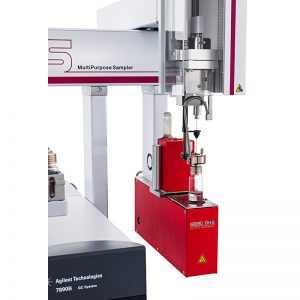Static (equilibrium) headspace injection is commonly used for GC determination of volatiles in solid and liquid samples. Since this technique relies on the analyte partitioning between the sample and headspace, and uses a fi xed injection volume, it may not provide adequate detection limits, particularly for higher molecular weight, higher boiling analytes.
In this study, we describe a new automated dynamic headspace analyzer that uses a two-needle design to flush the headspace of vessels ranging from 10 mL to 1.0 L onto replaceable adsorbent traps. The clean adsorbent traps are stored in a sealed tray on the x-y-z robotic sampler which transports them to the sample vessel, then directly to the integrated thermal desorber. This design enables automated optimization of trapping conditions including choice of adsorbent.
Performance of the new system was assessed using standard sample types and compared to traditional static headspace (HS) analysis and optimized SPME sampling. In general, better detection limits were obtained with dynamic headspace while maintaining reproducibility comparable to the other techniques.



